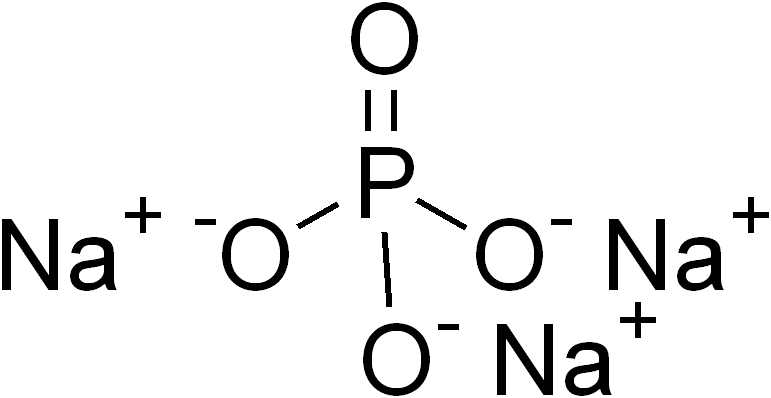Trisodium phosphate (TSP) is a common food additive that helps to regulate pH, emulsify ingredients, and stabilize food products. It is a white, crystalline powder that is highly soluble in water. It can also be called trisodium orthophosphate or simply sodium phosphate.
What is Trisodium Phosphate?
The chemical structure of trisodium phosphate consists of three sodium ions (Na+) and one phosphate ion (PO43-). The phosphate ion comprises one phosphorus atom bonded to four oxygen atoms. TSP is a strong base with a high pH, typically around 12. It is often partially hydrated and may range from anhydrous Na3PO4 to the dodecahydrate Na3PO4 · 12 H2O.

Source: Wikipedia
How is Trisodium Phosphate Produced?
Trisodium phosphate can be synthetically produced through several means. One process involves neutralizing phosphoric acid using sodium carbonate, which produces disodium hydrogen phosphate. The disodium hydrogen phosphate is reacted with sodium hydroxide to form trisodium phosphate and water.
Another method uses carboxamide and phosphoric acid in a ratio of 1.06:1. The concentrate is heated to 60-80°C. A phosphorus-ammonium compound intermediate is obtained in the reaction. It is reacted with sodium hydroxide in a ratio of 0.95:3. The mixture is cooled and subjected to crystallization to obtain trisodium phosphate.
Applications in the Food Industry
Trisodium phosphate is a multipurpose food additive widely used in the food industry. It serves the following functions:
| Function | Description |
| Acidity Regulator | TSP helps to control the acidity or alkalinity of food products, which is important for maintaining their stability, texture, and flavor. |
| Sequestrant | TSP can bind to metal ions and prevent them from reacting with other ingredients in the food. This is particularly useful in preventing oxidation and maintaining the color and freshness of certain food products. |
| Stabilizer | TSP helps maintain the food’s acidity or alkalinity, which is important for preserving the flavor and preventing spoilage. TSP can also enhance the color and appearance of certain food products. |
| Water Softener | Hard water contains high levels of minerals like calcium and magnesium, which can negatively impact the quality of food products. TSP acts as a water softener by binding to these minerals and preventing them from interfering with food processing. This is particularly important in applications like baking, where hard water can affect the texture and rise of baked goods. |
| Emulsifier | TSP works by altering the electrostatic interactions and by adsorption of ions at the interface. This helps create a stable emulsion, preventing oil and water separation. |
Product Examples
| Type | Examples |
| Convenience | Canned soups, cereals, cereal bars |
| Dairy & Dairy Alternatives | Cheese, cheese analogs |
| Bakery | Cakes, cookies |
| Beverages | Flavored beverages, acidic beverages, milk-based beverages |
| Meat | Processed meat products |
Properties of Trisodium Phosphate
| Physical Form | Crystals, powder |
| Color | Colorless |
| Odor | Odorless |
| Storage Temperature & Conditions | 15-25°C in a tightly sealed container |
| Molecular Weight | 163.940671 |
| pH (1% aqueous solution) | 11.5-12.5 |
| Density | 2.54 g/cc |
| Dielectric constant | 1.6 |
| Melting Point | 1583°C |
| Solubility | Freely soluble in water |
Typical Formulations
Processed Cheese
Here is an example of a processed cheese formulation with trisodium phosphate, along with the % concentration of ingredients:
| Ingredient | % Concentration |
| Cheddar cheese | 81-83 |
| Skim milk | 7.5 |
| Buttermilk | 7.5 |
| Salt | 1.0 |
| Trisodium phosphate | 2.5 |
| Sorbic acid | 0.1 |
Sodium phosphates are used in processed cheese to reduce salt content. These hydrated forms can dissolve faster in the aqueous phase of the cheese mixture during manufacture.
Source: Google Patents
Sausage
Here is an example of a sausage formulation with trisodium phosphate, along with the % concentration of ingredients:
| Ingredient | % Concentration |
| Pork shoulder | 40 |
| Pork backfat | 35 |
| Ice | 25 |
| Nitrite curing salt | 1.8 |
| Trisodium phosphate | 0.89 |
| Sugar | 0.5 |
| White pepper | 0.2 |
| Ascorbic acid | 0.05 |
| Glutamate | 0.05 |
| Coriander | 0.025 |
| Cardamom | 0.025 |
Source: NCBI
Trisodium Phosphate Formulation Considerations
| Physical Forms | Crystal, powder |
| Stability | – Hygroscopic: Rapidly absorbs water if exposed to a moist atmosphere – Decomposition: >75°C |
| Sensory Attributes | No peculiar taste or odor |
| Dosage | 0.05-1.5, depending on the application and desired effect |
| Interaction with Other Components | Not compatible with strong acids, strong oxidizing agents, or metal nitrates |
| Source | Synthetic |
TSP Hydrates
Different hydrated forms of trisodium phosphate typically have differing solubilities, making each useful for specific applications. TSP is available in a spectrum of anhydrous forms to dodecahydrate forms. The anhydrous form occurs when water is removed from hydrated salts. For example, anhydrous sodium sulfate is free of water. Therefore, anhydrous forms can be used as a drying material because they can absorb water and be converted into a hydrated form.
Effects on Properties of Food
- Emulsion stability: Trisodium phosphate is used in processed cheese as an emulsifying salt, as with other phosphates. The emulsifying effect of TSP is associated with its interaction with paracasein so that phosphate anions form bridges between protein molecules.
- Textural properties: Adding TSP to processed cheese improves its ability to flow due to the difference in calcium complexion. TSP also affects the hardness, gumminess, and elasticity of the product.
- Color stability: TSP can improve the color stability of food products by sequestering metal cations and preventing oxidative color degradation. One study demonstrated that adding TSP and other antioxidants improved the color stability of ground beef.
- Shelf stability: Phosphates have also been used as antimicrobial surface treatment agents to decrease populations of pathogens, prevent the growth of spoilage microorganisms, and extend the shelf life of fresh poultry. In a study, TSP helped to maintain the quality of apples during storage.
Safety and Regulatory Considerations
| FDA Information | Trisodium phosphate is considered “generally recognized as safe” (GRAS) as per the U.S. FDA when used per good manufacturing practice. |
| EU Information | Trisodium phosphate is a permitted food additive per the EU Commission regulation (EU) No 1130/2011. |
Health Effects of Trisodium Phosphate
Phosphorus is a naturally occurring mineral in various foods, including beans, milk, meats, eggs, fish, and nuts. It is crucial for bone health and cell repair, muscle and nerve function, and other processes within the human body.
A few studies report exercise performance enhancement due to sodium phosphate supplementation. The results indicate that TSP promotes improvements in the efficiency of the cardiorespiratory system during exercise in a hypoxic environment.
Safety & Toxicity of Trisodium Phosphate
In terms of toxicity, TSP is considered to have low acute toxicity. Ingestion of small amounts of TSP is unlikely to cause significant harm.
Identification Numbers
| IUPAC Name | Trisodium phosphate |
| CAS Number | 7601-54-9 |
| EC Number | 231-509-8 |
| INS No. (Food Additive) | INS 339(iii) |
| E Number (Food Additive) | E 339(iii) |
Acceptable Limits or Maximum Usage
The acceptable limit or maximum tolerable daily intake set per the JECFA for trisodium phosphate is 70 mg/kg bw expressed as P (phosphorus) from all sources.
The maximum usage level prescribed for sodium phosphates per the EU for various food categories is below.
| Category | Maximum Limit |
| Infant formula | 1000 mg/kg |
| Follow-on formula | 1000 mg/kg |
| Processed cereal-based foods and baby foods for infants | 1000 mg/kg |
| Other foods for young children | 1000 mg/kg |
| Dietary foods for infants for special medical purposes | 1000 mg/kg |
| Casings and coatings and decorations for meat | 12600 mg/kg |
TSP is also permitted to be used as food additives approved for use in food additives, food enzymes, food flavorings, and nutrients, as described below:
| Category | Maximum Limit |
| Enzymes preparations | 50000 mg/kg |
| Color E 163 Preparations | 40000 mg/kg |
Fun Facts About Trisodium Phosphate
- TSP has been employed in the seafood industry to enhance the firmness and texture of certain seafood products. It can help maintain the moisture content in processed seafood.
- TSP is also used as a precipitating agent, sequestrant, and softener in water treatment.








